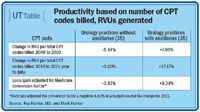Article
Analysis puts lower relative value units per current procedural terminology into perspective
By analyzing work relative value units (RVUs) in a number of urology groups, we have verified that they have had an approximate 10% decrease in income while generating the same number of work RVUs.


We decided to analyze productivity first. We looked back at production for several groups comparing number of CPT codes billed and number of RVUs generated (table). The numbers, as you may have guessed, are not uplifting.

The second set included those practices that do not bill directly for computed tomography, magnetic resonance imaging, or IMRT.
For purposes of this analysis, we are not adjusting for the number of providers as we are simply looking at general trends that will affect reimbursement in the current period and likely will affect future collections. We used our data cube (part of the Urology Data Initiative, our Web-based data portal), which includes offices for which we provide outsourced billing services as well as other groups that do their billing in-house or outsource to other billing services.
We have elected in this analysis to eliminate any adjustment for payer type; however, the RVUs are adjusted for payment rules as dictated by Medicare multiple procedure reduction and modifier adjustment related to global billing such as intraoperative payment only. The RVUs were not adjusted for geographic location in these sets of reports to allow for an apples-to-apples comparison.
Two factors contributing to the lower RVU per CPT in 2010 for the groups without ancillaries were:
Although these changes would have also affected groups with ancillary services, the results indicate that the practices that have added ancillaries are generating more RVUs per visit. It is important to note that we are not currently capturing billing data from imaging centers outside of urology offices, so it is not known whether the RVUs billed for the patient's care are similar in both types of practices.
The number of RVUs per CPT code is not dependent upon the number of patients seen by a practice. However, the number of patients seen and the CPT codes or RVUs per patient are also interesting to review as a different way to analyze production in the practice. With 80% of the market using an RVU-based compensation formula, a lower number of RVUs per CPT code will generally translate to lower income per CPT code. Thus, barring an increase in the number of CPT codes billed, a practice would likely have received a lower overall practice income in 2010 than in 2009.
We have not adjusted yet for the number of CPT codes per RVU for 2011 as the data set is still young. The number of CPT codes submitted in 2010 was generally lower versus 2009; however, initial data points to a rebound in number of CPT codes reported in 2011 year to date.




